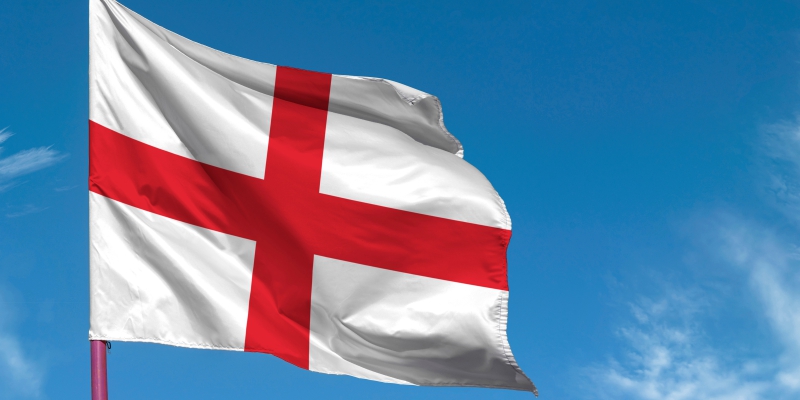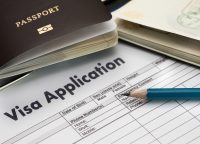The flag of Great Britain: the history of one of the world’s most famous symbols

The flag of Great Britain has long been not only a symbol of the state, but also an element of mass culture. Have you ever wondered why it looks like that and what all those crosses and lines mean? Now we will tell you everything!
The history of the flag of Great Britain
In 1603 Elizabeth I, the ruler of England, died. She left no heirs and in her place on the throne came the Scottish King James VI, whom she left as her successor. For England, he became James I.
It was then that the flags first endeavoured to unite. But the Scots were unhappy that the English cross was placed on top of their cross. The English resented the blue background instead of the classic white. But they did not dare to change it.
The middle of the seventeenth century was a tumultuous time for the island. There were periodic rebellions in Scotland and Ireland. These lands joined the commonwealth or declared independence. So the flags changed.
For example, the reunification of England with Ireland gave the flag a new look — so, a musical instrument (harp) appeared on the image.

The flag of 1649
Just two years later, Scotland rejoined the union, so the flag looked different again. The harp was removed, thus offending the Irish, but Scotland and England were honoured by adding crosses.

The flag of 1651
However, two years later they came to their senses and returned the harp.
As time went on, unruly Ireland seceded again, so that Great Britain then consisted of England, Scotland and Wales, which was always offensively forgotten to be displayed on the flag. And then prodigal Ireland returned to the family, so the flag had to be redesigned again. However, instead of a harp this time they took the cross of St Patrick and got the flag familiar to all of us.
Use of the UK flag
Not only official institutions, but also organisations and individuals are allowed to fly the flag. Previously, the flag could be hoisted over government buildings only on certain solemn and memorable dates. Now, agencies are allowed to use it on any other day at their discretion.
However, there are several dates when the flag must be flown at all times. These include Commonwealth Day, the birthdays of the King and Queen and some important members of the royal family, and other holidays. Of course, on days of mourning, the flag must be lowered.
Upside-down flag
The flag of Great Britain is not entirely symmetrical. The red diagonal lines are not centred on the white lines. Accordingly, the inner and outer edges, in relation to the shaft, are different.
Turning it upside down is considered an offence. The exception is the distress signal. However, we doubt that from afar it would be possible to distinguish the exact position of the stripes. On the other hand, it may have been a tactical trick at one time to signal a capture and impending ambush in such a way that only their own people could guess about it.
The flag of Great Britain in popular culture
The British flag is used in prints on clothing, accessories, souvenirs, interiors and even tattoos.
The British flag was largely popularised by rock and punk musicians, who were mostly in favour of anarchy rather than the monarchy at all.
Sex pistols
The most famous example of the use of the flag in music was the Sex Pistols’ rebellious hit God save the Queen, which, despite referring to the national anthem, criticised the existing system. Initially, the cover of the single did not contain an image of the flag, but now many people recognise it by its blue-white-red palette.
The Who
This is another legendary British rock band that used their country’s flag to its full potential. Just look at the cover of their vinyl The Kids Are Alright.
And frontman Pete Townsend occasionally wore a shirt made of the British flag. It was quite bold and provocative for those times.
The Queen
It would be strange if a band with such a name did not reflect this in their performances. The British flag was often one of the elements of the band’s stage sets. The band’s lead singer Freddie Mercury, for example, used to walk on stage with a flag.
Spice Girls
Not only rock musicians used the «British style». Many people remember the mini dress with the image of the British flag that Jerry Halliwell, an ex-member of a famous pop band, once wore. It was instantly copied by many brands, producing thousands of similar copies. And Gerry’s dress itself was sold at auction for £41,000.
Of course, this is not all examples when musicians used the symbolism of the British flag. A more detailed listing deserves a separate article.
The British flag and clothing
While many people have been inspired by the British flag, there are a few companies associated with this symbol particularly tightly.
Reebok
Nowadays this brand seems to be American and associated with the USA, however, its homeland is the United Kingdom. It is not surprising that from 1977 to 1986 the flag of Great Britain was a part of its logo. However, then its use was banned, and the logo had to be changed.
Dr Martens
This shoe brand, on the other hand, was not originally British — the first factory was opened near Munich. But now its history is inextricably linked with Great Britain. Of course, laconic monochrome models are considered classic. However, there have also been variants with British flag colours in the brand’s history.
Popular questions on the UK flag
What is the name of the flag of Great Britain?
The British flag has many names, such as the Union Flag or the Union Jack, etc.
The Union Flag — representing the joining together of the different parts of Great Britain.
Union Jack — This flag was originally used only on military and merchant ships. The place where the flagpole is located on ships is called the jack, so over time the flags themselves became known as such. This is the classical version, but there is a more alternative version. According to her, the name came from the name of James I, who in English is called James. Perhaps this is what later transformed into Jack.
What does the flag of the United Kingdom consist of?
Some people are surprised to learn that Britain and England have different flags because they think they are synonymous. In fact, this is not quite true. The fact is that Great Britain consists of four equal parts: England, Scotland, Wales, and Northern Ireland. It is not for nothing that this state is called the United Kingdom.
Therefore, the flag of Great Britain = the flag of England + the flag of Scotland + the flag of Northern Ireland. All flags have crosses on them.
What is the significance of crosses on flags?
All crosses have their own names and pay tribute to the saints who patronise lands:
- England — St George’s Cross;
- Scotland — St Andrew’s Cross;
- Ireland — St Patrick’s Cross.
Why is there no Welsh symbol on the flag of the UK?
The fact is that when the flag was created, England and Wales were already a United Kingdom and were counted as one unit.
What is interesting is that the emblem of Wales on the flag would not be another cross, but a red dragon. Although this symbol remained from the Romans, it then became associated with King Arthur and the legends about him.
In the United Kingdom, debates have erupted over whether to add a dragon to the UK flag. On the one hand, it would disrupt such a recognisable image. On the other hand, it seems unfair that Wales is absent from the common flag.
The dragon is not the only symbol that has appeared on the British flag. At one time there was also an Irish harp.




